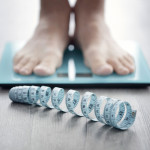Following on the heels of a published clinical trial showing that recombinant human growth hormone (rhGH) treatment is associated with reductions in unhealthy fat seen in HIV-positive people lipodystrophy, encouraging results from a second study were reported today at the XVI International AIDS Conference (IAC) in Toronto. The new data suggest that an initial 12-week induction course of rhGH, followed by lower-dose maintenance therapy, results in notable drops in visceral fat.
HIV-associated lipodystrophy generally involves two different types of body-fat changes. First there is a build up of fat. Some people see the amount of visceral fat – fat deep within the body – around their gut increase significantly (lipohypertrophy). Some people see the fat in their legs, arms, buttocks, or face diminish (lipoatrophy). These complications are associated with the use of HIV treatment, notably protease inhibitors and the nucleoside reverse transcriptase inhibitors Zerit® (stavudine) and Retrovir® (zidovudine).
While there are emerging therapeutic choices for lipoatrophy – facial fillers have become popular, albeit pricey, options – there has not yet been a clinically proven (or approved) therapy for lipohypertrophy.
When rhGH was being evaluated in clinical trials for HIV-associated wasting syndrome– it is approved by the U.S. Food and Drug Administration (FDA) and sold as Serostim® for this indication – the study investigators noted that the injectable hormone significantly reduced body fat (while increasing muscle mass). Based on this observation, rhGH was further explored in studies involving patients with lipodystrophy.
A study published in a March 2004 issue of the Journal of Acquired Immune Deficiency Syndromesindicated that 12 weeks of rhGH therapy at a daily dose of 4mg was associated with significant decreases in visceral fat compared to pre-treatment levels.
In the phase III follow-up study reported by Carl Grunfeld, MD, of the University of California, San Francisco, 325 HIV-positive people with lipodystrophy were randomized to receive either 4mg daily injections of rhGH or placebo for 12 weeks– the induction phase of the study. For the next 24 weeks, patients who initially received induction therapy with rhGH were again randomized to take 2mg rhGH on alternate days or placebo – the maintenance phase of the study. Patients originally randomized to placebo continued for 24 weeks and then later received 4mg rhGH.
After12 weeks induction treatment, patients in the rhGH group experienced an average decrease in visceral fat of 32 centimeters squared (cm2),compared to an average increase in visceral fat of 0.5 cm2 in the placebo group. This difference between the rhGH group and the placebo group was statistically significant, meaning that it was not due to chance.
By the end of the maintenance phase of the study, Dr. Grunfeld reported, reductions in visceral fat were generally maintained among patients who remained on rhGH during the entire 36weeks of the study. Among those who continued on alternate-day 2mg rhGH dosing, approximately 40% regained at least 50% of the visceral fat they had lost during the induction phase of the study. This, however,was considered a success according to the way the study was designed.Among those who were on rhGH induction therapy and then switched to placebo, 53.7% regained at least 50% of the visceral fat they had lost.This was considered a failure.
There has been some concern that rhGH would also reduce limb fat – such as in the arms,legs, and face – which could be problematic for people already suffering from lipoatrophy. After 12 weeks of induction treatment,limb fat did decrease in the rhGH group compared to those who took placebo, with statistically significant differences between the two groups. However, by week 36, limb fat measurements were again similar to those seen before treatment with rhGH was started.
Of note, levels of non-HDL cholesterol – so-called “bad” cholesterol – decreased in response to rhGH treatment. However, it should be noted that patients were permitted to take lipid-lowering statins while participating in the rhGH study.
No unexpected side effects were reported. Muscle and joint pain, as well as tissue swelling, were common. For example, tissue swelling was seen in approximately 46% of patients receiving rhGH during the induction phase of the study. But by the end of the maintenance phase of the study,tissue swelling was only seen in 7% of patients on low-dose rhGH.
Another concern surrounding rhGH therapy is its potential to cause glucose intolerance, a potentially serious problem for people who are already diabetic or pre-diabetic due to the HIV medications they take. In this study, glucose levels increased during the first few weeks of the induction phase of the study, but were back down to pre-rhGH treatment levels by the time maintenance therapy was started.
Dr.Grunfeld concluded that 4mg rhGH induction therapy for 12 weeks,followed by 24 weeks of 2mg rhGH every-other-day maintenance treatment,achieves significant and lasting reduction in visceral fat and is relatively well tolerated.
An application requesting approval of rhGH for lipodystrophy has been submitted to the U.S. Food and Drug Administration by Serono and is currently being reviewed.

Istock






Comments
Comments